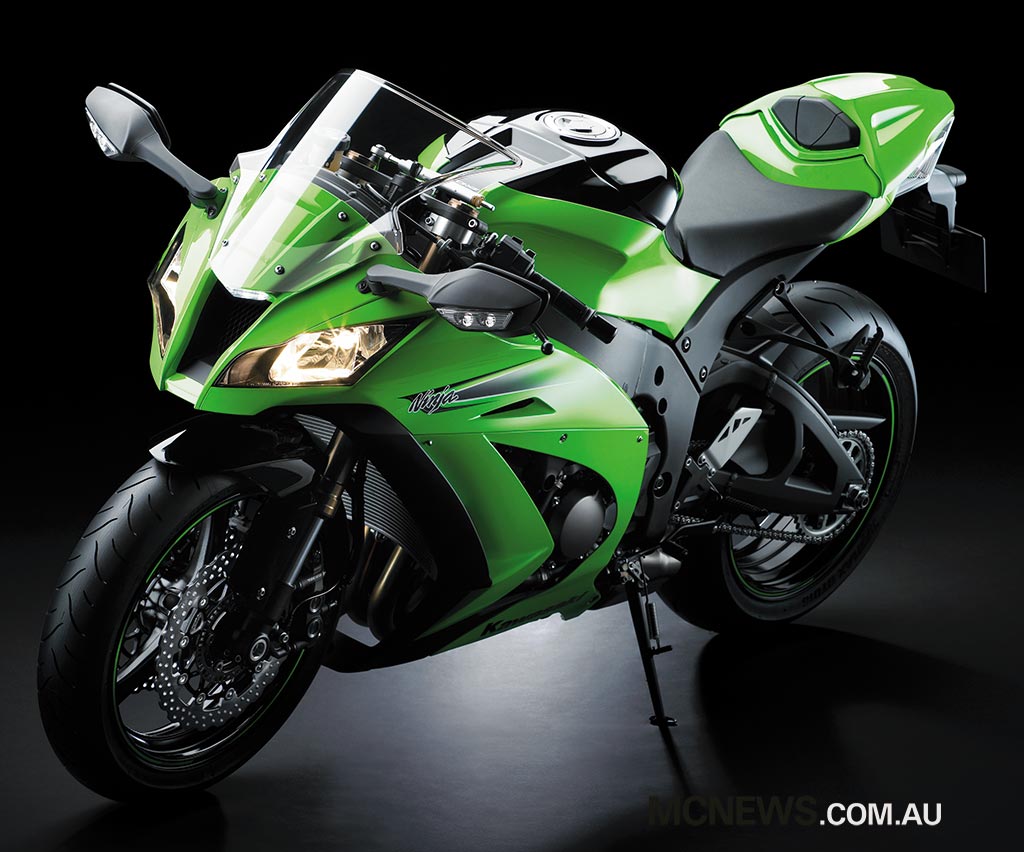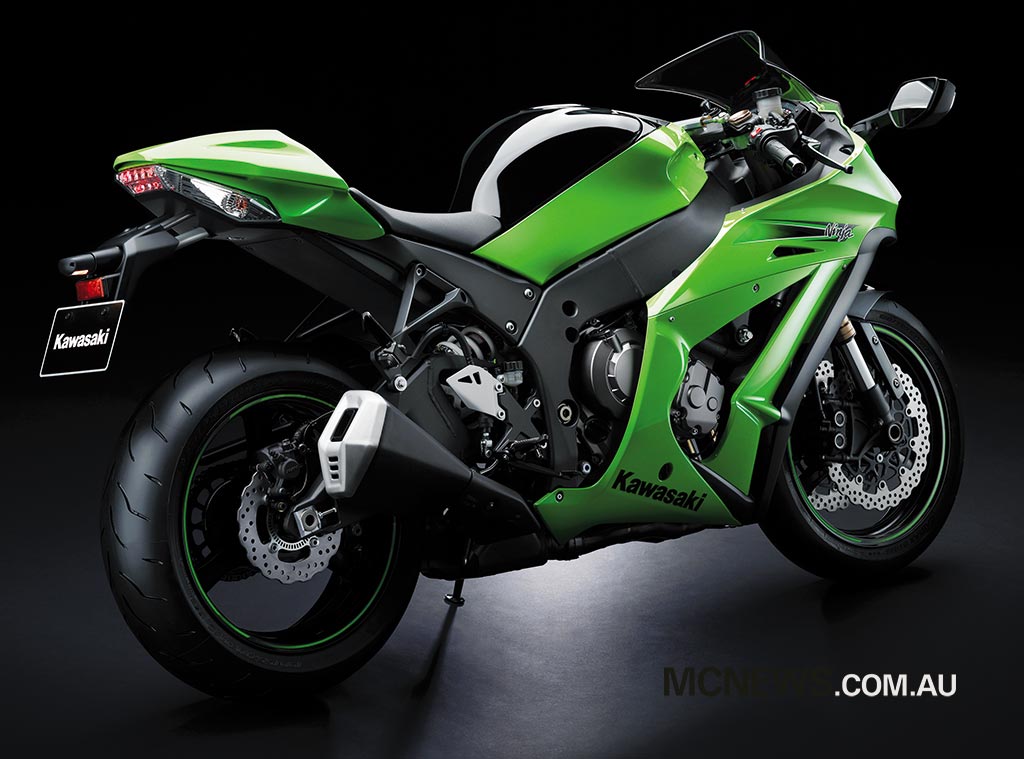2011 Kawasaki ZX-10R Tested
By Trevor Hedge
It’s no secret that for many years Kawasaki has been left behind by their Japanese brethren, in the race for 1000cc sportsbike supremacy. Taking a different development cycle to their competitors, who have also delayed new models due to the GFC, Kawasaki were already so far advanced with the new ZX-10R that it was brought to market for 2011 despite the GFC. Although it too debuted a year later than originally planned.
As a result the ZX-10R is the only ‘new’ 1000cc Japanese sportsbike on the market and one glance at the technology the machine bristles with, clearly underlines that fact. Weighing 10kg less than its predecessor, this is no mid-life model update; the 2011 ZX-10R is completely new from the ground up. With Kawasaki’s withdrawal from MotoGP, many of the engineers from that defunct project worked on the ZX-10R, and the bike is the product of their best and brightest engineers.
Fully featured and sophisticated traction control married with a sportsbike-tuned ABS system has, for the first time in recent memory, made its contemporaries look old hat. Sure, the Europeans have offered such innovation for a couple of years now, but Kawasaki is the first Japanese manufacturer to tread this brave new ground of traction control. Honda does have optional ABS on the Fireblade but no traction control. The ZX-10R does not have the electronic steering damper system utilised by its rivals, however it does score a tasty adjustable Ohlins steering damper to make up for it.
Electronic trickery is all well and good as long as it works and I am glad to say that Kawasaki’s systems work well. During my first decent fang on the ZX-10R I hit a dirty patch on the road exiting a right-hander and the ZX-10R’s traction control caught it smoothly without impeding forward progress too much. I was still fresh and the machine was fairly upright so I would have caught the slide myself, and perhaps even extended it a little if I had taken my tough pills that morning, but the ZX-10R did it faster and with less fuss than I could have managed. I immediately thought how much of a plus the system would prove to be at the end of a long day when fatigue has set in and you are not on top of your game. Of course the benefits for riders moving up to their first big power sportsbike go without mention.
The traction control system has three modes with Level One the least obtrusive. Level three sees the machine render wheelspin non-existent, while level two allows a comfortable amount of slip or slide without intervening too harshly. Level one permits some seriously sideways attitude and allows for throttle modulation of a slide, intervening only when things get alarmingly lurid. The three modes are thoughtfully selectable from the bars on the fly and the power interruptions when made are much more subtle and smooth than the class leading BMW.
The only niggle I had with the system was that the wheelie-control component of the bag of tricks didn’t seem all that predictable. At times the front wheel was permitted to hover a foot or so off the deck under acceleration while at other times it was brought back to terra-firma quickly, before yanking back in the air as the electronics allowed the power back on. One-wheel antics with any level of grace demand traction control to be switched off.
Well-tuned modern ABS systems are a far cry from earlier generations that simply extended your stopping distance and felt horrible through the lever rather than doing anything to improve safety. Those days are long gone, with today’s ABS a great boon for the street rider, and unless you are an accomplished trackday merchant, modern sportsbike ABS is also efficient enough to leave turned on during an occasional foray to the track.
It’s not fool-proof; if you arrive at a corner 100km/h too fast it won’t stop you head butting a tree, but it will help you to wash off a lot of speed while retaining some semblance of control. If you are proficient enough to successfully control front and rear end slides in a panic stop situation when a car or kangaroo suddenly blocks your path, then good luck to you. But remember, ABS is not so much there for your concentrated expert application of the stoppers at your anticipated braking marker, it is there for those unexpected emergency stops or when you come across an invisible patch of diesel on the road while under brakes. That’s when it can save your bacon – and possibly even your life.
Experts and philistines can choose to have the ZX-10R without ABS and save themselves a grand in the process if that’s their choice. We only tested the ABS version of the ZX-10R and could only make the system intervene through purposeful ham-fistedness to simulate a panic stop, which is just the way you want it. The system was impressively smooth and consistent in operation and added a comforting extra touch of security and confidence while riding some fairly treacherous roads. Adding more confidence to the braking package was the standard slipper clutch system that aids the Kawasaki’s stability under brakes, albeit with the rear still wavering in the air a little. Overall I rate the brakes as officially awesome, perhaps the best around.
Negotiating some favoured tight mountain roads my favourite highlights of the ZX-10R shone through. Excellent small bump compliance from the new Showa big-piston forks and sublime throttle response somewhat surprising traits from a hard-core sportsbike, but certainly very welcome all the same.
Even in full power mode (the Kawasaki has three power levels to choose from), the response from the throttle was so smooth you could be forgiven for thinking it was a low-power commuter bike. Of course the g-forces produced by the stratospheric rate of acceleration soon put paid to that mistaken impression! The fact remains that I could use first gear on the ZX-10R with purposeful intent, where on most comparable machines the response would have been too savage to contemplate using first. Instead, I would have used second or third gears to smooth progress and ensure traction.
First gear runs to 166km/h on the digital speedometer and on my favourite tight roads it was a joy to effectively use it almost exclusively, without the machine threatening to get unruly. Perhaps the ZX-10R being a little softer in the mid-range than comparable machines combined with very tall gearing also aided my progress and helped smooth the show even more. If I was to be unfair I would say that the tall gearing perhaps dulled the experience rather than just tamed it a little, but the truth is I really enjoyed leaving the thing in first gear while negotiating tight and tricky bends before blasting out the other side. Circuit punters will definitely want to shorten the gearing by adding a few teeth to the rear sprocket. An electronic quick-shifter would be nice also.

Like all litre sportsbikes, the top end of the ZX-10R is beyond the comprehension of anyone that hasn’t ridden one. Without the security of a back-to-back dyno test I still feel comfortable stating that the ZX-10R is the most powerful Japanese sportsbike on the market, and second only to BMW’s S1000RR when it comes to outright space-time continuum bending 12,000rpm plus expletive laden intergalactic teleportation. Did I get close to effectively describing the top end power? I could have perhaps shortened it to a four-letter word said slowly starting with the character F and suffixed with an exclamation mark, but that would just be crude…
On the chassis side of the equation the new forks combine with fairly reasonable ergonomics, for a sportsbike, to deliver a thoroughly sporting ride while maintaining a fair semblance of comfort. A fairly low seat and liveable reach to the bars along with adjustable pegs mark the ZX-10R quite liveable on the street. Even the mirrors are useable without performing a calisthenics manoeuvre.
Up the pace and the Kawasaki responds with the forks firming nicely through the stroke and shrugging off braking and turn-in forces as brilliantly as they deal with small road irregularities. The feedback is communicative and like the new, similarly equipped Suzuki GSX-R750, these new Showa forks really do bring race levels of performance to the street, minus the bone-jarring levels of rebound and unruliness common to an Ohlins-equipped Ducati for instance.
At the rear Kawasaki has done something a little different, and it feels different. The fully-adjustable shock and linkage is positioned above the swingarm, well out of the way of road crud and allowing for much easier adjustment of preload. It never gave me cause for complaint but there is no doubt whatsoever that it feels unusual. I don’t really know exactly how to describe that feeling in fine detail as I didn’t quite understand it myself. It certainly didn’t hold me back at all on the street. At the track, however, I imagine it might take some time to familiarise yourself before gaining full confidence.
Overall, I found very little to complain about in regards to the performance of the ZX-10R. I don’t particularly like the way it looks, hate the star-trek style LCD tachometer and the indecently slim rear bodywork profile makes my arse look even fatter than it actually is.
Those concerns aside, this machine firmly reinstates Kawasaki’s credentials as a big-bore sportsbike manufacturer like no other machine in recent memory. Technically the ZX-10R is a polished product in a way that it, or perhaps any Kawasaki model for that matter, has never been before. Team Green is back.
Specs – Kawasaki ZX-10R
Engine – 998cc, liquid cooled, DOHC, in-line four-cylinder
Bore x Stroke – 76 x 55mm
Transmission – Six speed, chain final drive
Seat Height – 813mm
Wet Weight – 201kg
Fuel Capacity – 17 Litres
Average Consumption on test – 6 litres per 100km
Range – 280km
Warranty – Two years
Price – Expect to pay around $19,990 plus applicable stamp duties and registration charges for ABS version as tested
Verdict – ****
Positives
+ Intelligent electronics package
+ Big top end power
+ Great bump compliance
+ Smooth throttle response
+ Wonderful stoppers
Negatives
– Not the prettiest kid on the block
– Low and mid-range not as strong as comparable machines
– Pictorial – Image gallery featuring the 2011 Kawasaki ZX-10R
























